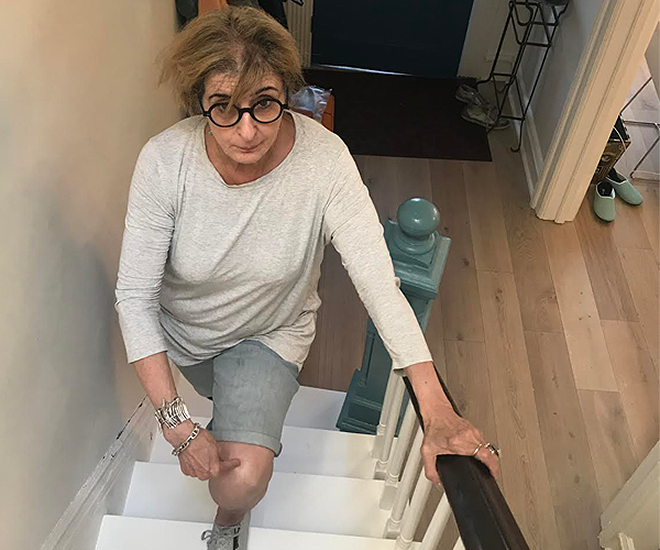Dear FOFriends: Osteo Bi-Flex has compensated FabOverFifty for this blog. I assure you that the content is factual and valuable, and all opinions are my own! – Geri Brin
After working out with Vann recently, I felt stiffness in my left knee when I walked up and down stairs. Uh oh. What’s going on inside that knee? What causes me to have occasional joint stiffness, and besides, what’s a joint anyway?

Vann told me to take it easy on the knee and instructed me to do a specific stretching exercise, which eased the stiffness rather quickly. But I wanted to learn more about my joints, so I called Osteo Bi-Flex, which manufactures a broad line of supplements for joint health. I’d been seeing their TV commercials a lot lately, and we had started to work with the brand because joint, bone and health concerns surely can impact our lives.
 The brand put me in touch with Susan Hazels Mitmesser (Dr. Susan), Senior Director, Nutrition & Scientific Affairs at The Nature’s Bounty Co., the parent company of Osteo Bi-Flex. A research scientist with nutritional biochemistry experience, Dr. Susan provides “strategic scientific leadership for innovation and new product development, improving existing products, and ensuring the scientific integrity of all the company’s brands and products.”
The brand put me in touch with Susan Hazels Mitmesser (Dr. Susan), Senior Director, Nutrition & Scientific Affairs at The Nature’s Bounty Co., the parent company of Osteo Bi-Flex. A research scientist with nutritional biochemistry experience, Dr. Susan provides “strategic scientific leadership for innovation and new product development, improving existing products, and ensuring the scientific integrity of all the company’s brands and products.”
Dr. Susan was a wonderful teacher, and now I have the pleasure of sharing her information-packed lesson with you. Do yourself a big favor and learn it, too!
![]()
Geri: Please tell us, in layman’s terms, about the structure of our joints.
Dr. Susan: “I’m going to use the knee joint as an example, but for the most part, our joints are all going to be made up of the same types of tissues. The bone in a healthy joint is not touching another bone, but is separated from another bone by a fluid, known as synovial fluid, which is surrounded by the synovial membrane. This fluid is very liquid and provides cushioning and lubrication to the joint. Cartilage, located on the edge of the bone, reduces friction and acts almost as a shock absorber.
“Ligaments join bone to bone, and tendons attach our muscles to the bones. All these pieces and parts work nicely together in a nice healthy joint.”

Just curious, can someone have strong muscles, but weak joints?
“Yes, that could be caused by a genetic or environmental factor. Someone who experienced a severe sports injury, for example, could still have muscle strength and mass, but the synovial fluid, ligament, cartilage or tendon in the joint could have been damaged by the injury.”
WILL EVERYONE EVENTUALLY EXPERIENCE JOINT COMFORT ISSUES?
“The degradation of the cartilage and the connective tissue between bones will happen naturally over time, but the rate at which it happens will differ from person to person, and will depend on your environment, on your diet, and on your daily activities.”

ARE CERTAIN PEOPLE MORE PRONE TO JOINT COMFORT ISSUES?
“Postmenopausal women are definitely more prone. There’s a link between lower circulating estrogen levels in menopausal women and increased risk of joint issues.
“Women and men who carry excessive weight on their joints, especially on their lower extremities, also are at higher risk. And, improper exercise puts you at increased risk for injury.”
CAN WE DO ANYTHING TO SLOW JOINT ISSUES, AND WHAT’S THE IDEAL TIME TO START TAKING CARE OF OUR JOINT HEALTH?
“We can take steps to take care of our joints earlier on. The younger we start caring for our joints, the better. Joint comfort issues are the result of normal wear and tear on your joints, so treating them well, early on, will have a long-term positive effect. We’re always using our joints in everyday activities, whether we’re walking or reaching high to grab something off the shelf. But it’s never too late to start taking care of them. Even in your 70s and 80s, you can do things to address joint comfort concerns, such as:
1. “Treating an injury kindly. Don’t ignore it. “If you ‘muscle your way’ through an injury, it can lead to further damage. Untreated injuries can lead further damage to the joint or in a muscle that’s supporting the bone, or to the cartilage at the end of the bone. So, if you do feel something is off, consult your physician.
2. “Exercising appropriately is one of the best things you can do for your joints, even though it seems counter-intuitive. This will ensure the strength of the muscle around the joints, and help you maintain your flexibility and range of motion. You absolutely want to work your joints in a healthy range of motion. Making sure you like your exercise regimen will help you stick to it. A combination of weight-bearing and non-weight-bearing exercise is best, and flexibility exercise helps you to keep the range of motion.

3. “Nutrition, of course, is important since one of the risk factors of joint issues is being overweight. Manage your weight appropriately by eating fruits, vegetables and whole grains. And don’t forget the water.”
“It’s been estimated that for every pound of body weight lost, there’s a four-pound reduction on the workload on your knees. Now, that’s an impact your joints will appreciate!”
PLEASE TELL US HOW OSTEO BI-FLEX TRIPLE STRENGTH (WITH TUMERIC) CAN HELP SUPPORT OUR JOINT HEALTH?*
 “Curcumin is actually one of the components of turmeric. And curcumin is used interchangeably with the term Curcuminoid which is a compound responsible for the yellow color of turmeric. Think of turmeric as the whole root, and within that root you have curcumin and then curcumin molecules are made up of curcuminoids.”
“Curcumin is actually one of the components of turmeric. And curcumin is used interchangeably with the term Curcuminoid which is a compound responsible for the yellow color of turmeric. Think of turmeric as the whole root, and within that root you have curcumin and then curcumin molecules are made up of curcuminoids.”
Osteo Bi-Flex® Triple Strength + Turmeric contains glucosamine which helps strengthen joints while helping to maintain joint cartilage essential for comfortable joint movement.* Turmeric has been a staple of traditional health practices for centuries. The Curcumin in Turmeric is what gives it its antioxidant power.* The Turmeric in our product is specifically designed to provide the most optimal levels of Curcumin available.
CAN WE GET ENOUGH TURMERIC FROM FOOD?
“That would be very difficult to do. Turmeric is prevalent in the Indian and Thai diets, but the amount of curcuminoid they get still is small. It’s really hard to eat that much turmeric with the American diet. A woman who has proper nutrition and exercise would be wise to supplement her diet with Osteo Bi-Flex Triple Strength.”

GIVEN THERE IS A RANGE OF OSTEO BI-FLEX FORMULAS, HOW DOES A WOMAN KNOW WHICH ONE WILL BE MOST EFFECTIVE FOR HER?
“Not all of us metabolize things the same way, so one women may do better taking Osteo Bi-Flex with vitamin D, or Ease, which is a smaller pill. We don’t believe ‘one size fits all.’ Each woman needs to take responsibility for what is lacking in her diet and what lifestyle she wants to lead. It’s also important to reach out to your health care provider or a nutritionist for advice.”
*These statements have not been evaluated by the Food and Drug Administration. These products are not intended to diagnose, treat, cure or prevent any disease. Individual results may vary.

